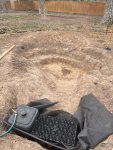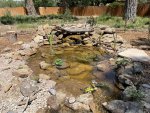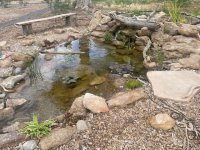Sure! Here you go. I would say my main lessons learned are:
1. Build the walls of the bog higher relative to the waterfall/spillway. Ideally at least 4-6 inches above the water level in case it gets clogged/crowded, that way water won't back up out your bog walls. So far I'm okay but if it's too close for comfort with my current design. Maybe next summer I'll raise the walls as I do have extra liner tucked in under the caps of the bog wall.
2. Think about how plants will impact the flow of debris into the intake bay. Without any plants, the intake bay worked like a charm. It still works, but a lot of leaves get stuck in the middle of the lilies and the parrots feather. I just need to poke it with a stick or something and it will usually come free, but just one more little thing to think about. I might rearrange some plants to free up a path through the middle for debris.
3. My water is crystal clear, but I did have quite a bit of string algae that I had to clear periodically from the pond and bog for esthetic reasons. It absolutely dominates the waterfall. I don't mind the look so much but I was hoping the bog would cut down on the algae. I'm guessing year two the plants will be more established and be better able to suck up nutrients. I'm also going to add some more submerged aquatic plants. The pond is in pretty close to full sun from about 10am to 3pm in the summer, which I'm sure contributes. I'm also using well water which has a decent baseline phosphate level.
4. I didn't really appreciate how much the wind in Albuquerque was going to blow gunk into the pond. Cottonwood season I could have cleaned out the intake bay 3 times a day if I wanted to. It was literally covered in cottonwood fluff all the time. Pretty sure a skimmer might have gotten clogged from the fluff. Very curious to see how crazy fall is going to get with leaves to clear out.
5. A lot of the plants took quite a while to get established, so if you can it planted in the spring, rather than early summer when I did it would be better. Overall most things took off well. I even sprouted a few cuttings (rosemary) by just putting them in the bog and they grew roots and everything. Love the Yerba Mansa in the bog.
6. Goldfish really don't need supplemental food. I started with 2 sarasa comet goldfish and 2 shubunkins. I now have one baby that made it to the big leagues and hangs out with the big fish, and several mid-size babies that if they make it through the winter might join the club, and then many smaller babies that I think aren't going to make it? Who knows. I've literally fed the fish four times. If anyone in Albuquerque wants a big thing of fish food that I bought thinking I was going to need it feel free to message me.
7. During the peak of summer I was losing a TON of water to evaporation. I was really paranoid I had leak or something but it's just that hot and dry here. I set up a 1/4 inch line attached to the backyard irrigation that runs into the pond so whenever the sprinklers run it gets topped off a bit, and I can adjust the flow down (now) when there's lower evaporation or if it rains. I didn't bother with a float valve but eventually that would probably be the better solution.
8. Build some tolerance for multiple water levels. I sort of lucked into this, but the intake bay has about a 4.5 inch water height variability between minimum and maximum which offers plenty of cushion (so far). If the water level drops below that, the pump will stop working, but the fish will at least have water because the water will stay at the bottom level of the intake bay if that makes any sense. All my plumbing is within the pond so the only real potential disaster is a hole in the liner somewhere, or the bog developing a big leak, but even then the main pond would retain its water.
9. Plants that have done the best: Yerba Mansa is native to here and has grown super well and spreads by runners. It's also beautiful in bloom, and tolerant of our alkaline soil/water. Cardinal flower took a while to get established but eventually gave off some awesome late summer flowers that the hummingbirds loved just as they were getting ready to leave. The swamp milkweed I planted also took a while to get established, and it didn't bloom this year, but I'm optimistic for next year. Hardy lillies and the lotus did super well, although I battled aphids all summer. Chocolate mint also did great and spread well. Several other plants suffered from iron chlorosis from the alkalinity but survived and seemed like they eventually adapted. Those include water plantain, irises, Mexican heather. The only thing that died completely was a native gooseberry I thought might have a shot but I think the bog was just too wet for it.
Happy to answer any questions! You're welcome to come over some time and take a look (I think you're in Albuquerque if I remember correctly!)













